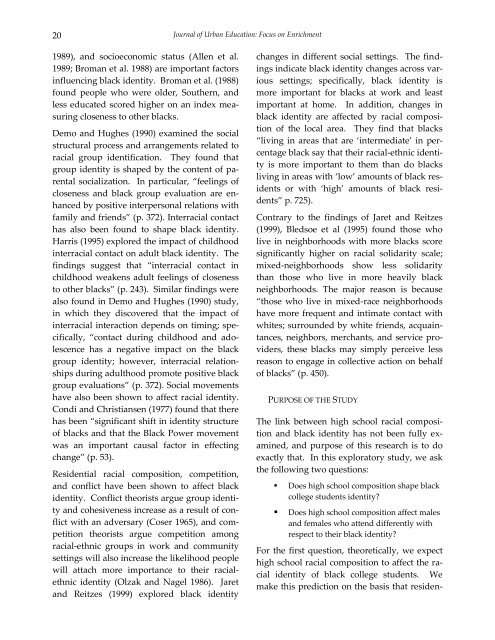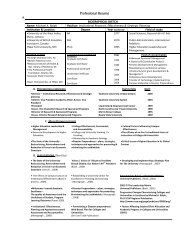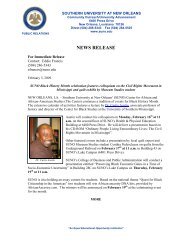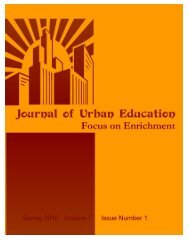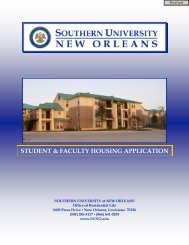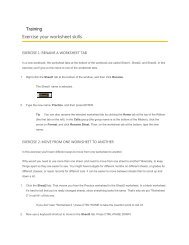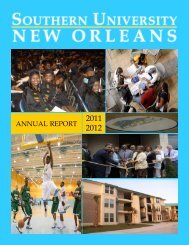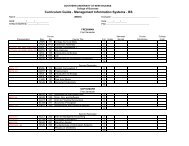Journal of - Southern University New Orleans
Journal of - Southern University New Orleans
Journal of - Southern University New Orleans
- No tags were found...
Create successful ePaper yourself
Turn your PDF publications into a flip-book with our unique Google optimized e-Paper software.
20<strong>Journal</strong> <strong>of</strong> Urban Education: Focus on Enrichment1989), and socioeconomic status (Allen et al.1989; Broman et al. 1988) are important factorsinfluencing black identity. Broman et al. (1988)found people who were older, <strong>Southern</strong>, andless educated scored higher on an index measuringcloseness to other blacks.Demo and Hughes (1990) examined the socialstructural process and arrangements related toracial group identification. They found thatgroup identity is shaped by the content <strong>of</strong> parentalsocialization. In particular, ‚feelings <strong>of</strong>closeness and black group evaluation are enhancedby positive interpersonal relations withfamily and friends‛ (p. 372). Interracial contacthas also been found to shape black identity.Harris (1995) explored the impact <strong>of</strong> childhoodinterracial contact on adult black identity. Thefindings suggest that ‚interracial contact inchildhood weakens adult feelings <strong>of</strong> closenessto other blacks‛ (p. 243). Similar findings werealso found in Demo and Hughes (1990) study,in which they discovered that the impact <strong>of</strong>interracial interaction depends on timing; specifically,‚contact during childhood and adolescencehas a negative impact on the blackgroup identity; however, interracial relationshipsduring adulthood promote positive blackgroup evaluations‛ (p. 372). Social movementshave also been shown to affect racial identity.Condi and Christiansen (1977) found that therehas been ‚significant shift in identity structure<strong>of</strong> blacks and that the Black Power movementwas an important causal factor in effectingchange‛ (p. 53).Residential racial composition, competition,and conflict have been shown to affect blackidentity. Conflict theorists argue group identityand cohesiveness increase as a result <strong>of</strong> conflictwith an adversary (Coser 1965), and competitiontheorists argue competition amongracial-ethnic groups in work and communitysettings will also increase the likelihood peoplewill attach more importance to their racialethnicidentity (Olzak and Nagel 1986). Jaretand Reitzes (1999) explored black identitychanges in different social settings. The findingsindicate black identity changes across varioussettings; specifically, black identity ismore important for blacks at work and leastimportant at home. In addition, changes inblack identity are affected by racial composition<strong>of</strong> the local area. They find that blacks‚living in areas that are ‘intermediate’ in percentageblack say that their racial-ethnic identityis more important to them than do blacksliving in areas with ‘low’ amounts <strong>of</strong> black residentsor with ‘high’ amounts <strong>of</strong> black residents‛p. 725).Contrary to the findings <strong>of</strong> Jaret and Reitzes(1999), Bledsoe et al (1995) found those wholive in neighborhoods with more blacks scoresignificantly higher on racial solidarity scale;mixed-neighborhoods show less solidaritythan those who live in more heavily blackneighborhoods. The major reason is because‚those who live in mixed-race neighborhoodshave more frequent and intimate contact withwhites; surrounded by white friends, acquaintances,neighbors, merchants, and service providers,these blacks may simply perceive lessreason to engage in collective action on behalf<strong>of</strong> blacks‛ (p. 450).PURPOSE OF THE STUDYThe link between high school racial compositionand black identity has not been fully examined,and purpose <strong>of</strong> this research is to doexactly that. In this exploratory study, we askthe following two questions:• Does high school composition shape blackcollege students identity?• Does high school composition affect malesand females who attend differently withrespect to their black identity?For the first question, theoretically, we expecthigh school racial composition to affect the racialidentity <strong>of</strong> black college students. Wemake this prediction on the basis that residen-


